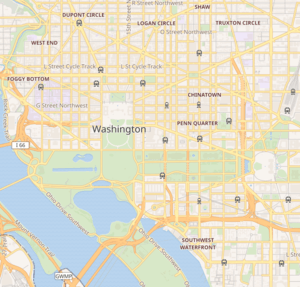American Peace Society house
The American Peace Society House, also known as the Glover House, is a historic house at 734 Jackson Place NW, facing Lafayette Square in the heart of Washington, D.C. Built in 1878 for banker and philanthropist Charles Carroll Glover, it is most notable as the national headquarters of the American Peace Society from 1911 to 1948. The Peace Society was one of the first overtly pacifist organizations in the nation, with a history dating to 1815. The house was declared a National Historic Landmark in 1974.[2][3]
American Peace Society | |
U.S. National Historic Landmark District Contributing Property | |
   | |
| Location | 734 Jackson Pl., NW., Washington, D.C. |
|---|---|
| Coordinates | 38°53′58″N 77°2′19″W |
| Built | 1878 |
| Architectural style | Italianate |
| Part of | Lafayette Square Historic District (ID70000833) |
| NRHP reference No. | 74002155 |
| Significant dates | |
| Added to NRHP | September 13, 1974[1] |
| Designated NHL | May 30, 1974[2] |
| Designated NHLDCP | August 29, 1970 |
Description and history
The former American Peace Society House stands on the west side of Jackson Place, the street flanking Lafayette Square's west side. It is one of a series of row houses, built of brick with sandstone trim. It is three stories in height, with a two-bay front facade. The entrance is in the right bay, and the left bay has a two-story polygonal projecting bay. Windows are framed by bracketed hoods that are segmental arches on the first floor, and shallow gables on the upper levels. The entrance is set under a bracketed segmented-arch opening with flanking paneled pilasters.[3]
The house was built in 1878, and its first prominent occupant was Charles Carroll Glover, a prominent Washington banker and philanthropist. In 1902 it was briefly occupied by the War College Board.[4] From 1911 to 1947 it served as the headquarters of the American Peace Society. The Society has its origins in a number of local and state peace societies organized in the early decades of the 19th century, the oldest of which, the New York Peace Society, was founded in 1815. In 1828 these disparate groups came together, creating the nation's first organization dedicated to the promotion of international peace.[3]
In the 1970s the house was occupied by the American Revolution Bicentennial Commission, by which time it had been combined by the creation of openings in party walls with one of the adjacent units.[3] The series of rowhouses it is part of now belong to the federal government, and are managed by the General Services Administration.[5]
See also
References
- "National Register Information System". National Register of Historic Places. National Park Service. January 23, 2007.
- "American Peace Society". National Historic Landmark summary listing. National Park Service. Archived from the original on 2011-06-06. Retrieved 2008-04-24.
- Carol Ann Poh (October 26, 1973). "National Register of Historic Places Inventory-Nomination: American Peace Society" (pdf). National Park Service. Cite journal requires
|journal=(help) and Accompanying one photo, exterior, from 1973 (32 KB) - Hovey, Lonnie (2014). Lafayette Square. Arcadia Publishing. p. 53. ISBN 9781467122030.
- "West Side Properties". US GSA. Retrieved 2017-04-28.
| Wikimedia Commons has media related to American Peace Society House. |